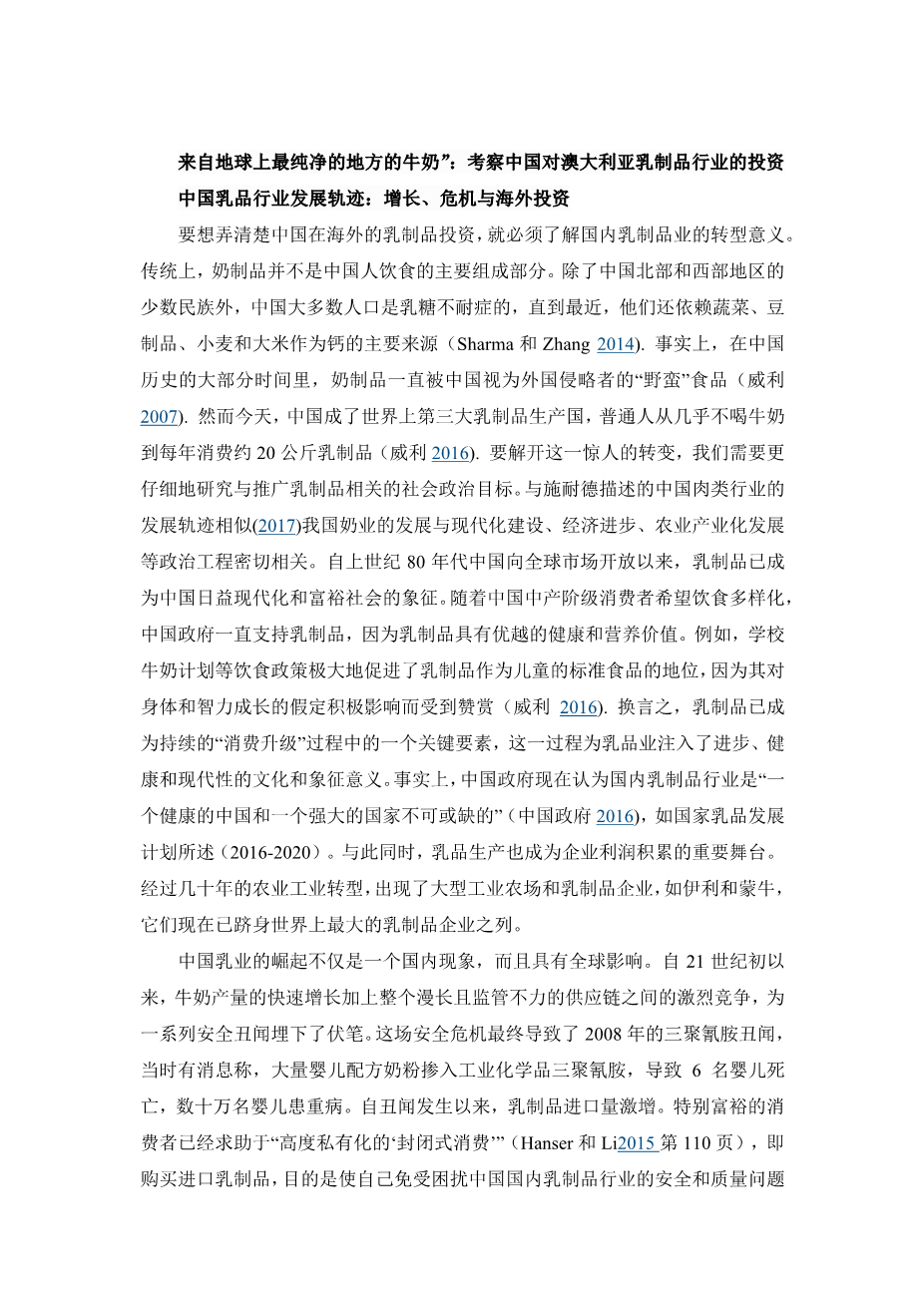原文:来自Agriculture and Human Values
2021-02-13 | journal-article
Development trajectories in Chinarsquo;s dairy sector: growth, crisis, and overseas investments
Making sense of Chinese dairy investments abroad requires an understanding of the transforming meanings of dairy at home. Traditionally, dairy has not been a major component of the Chinese diet. With the exception of ethnic minorities in the Northern and Western regions of China, the majority of the countryrsquo;s population is lactose intolerant and, until recently, has relied on vegetables, bean products, wheat, and rice as main sources of calcium (Sharma and Zhang 2014). Indeed, throughout most of Chinarsquo;s history, dairy has been shunned as the lsquo;barbarianrsquo; food of Chinarsquo;s foreign invaders (Wiley 2007). Yet today, China is the third-largest dairy producer in the world, and the average person has gone from hardly drinking any milk at all to consuming around 20 kg of dairy products a year (Wiley 2016). To unravel this stunning transition, we need to take a closer look at the socio-political goals linked to the promotion of dairy. Similar to the trajectory of Chinarsquo;s meat sector described by Schneider (2017), the growth of Chinarsquo;s dairy industry is closely associated with a political project of modernization, economic progress, and agro-industrial development. Since China opened up to global markets in the 1980s, dairy has become a symbol of Chinarsquo;s increasingly modern and affluent society. As Chinese middle-class consumers look towards diversifying their diets, the government has championed dairy products for their superior health and nutrition benefits. For example, dietary policies such as school milk programs have significantly contributed to dairyrsquo;s status as a normative food for children that is appreciated for its putatively positive effects on physical and intellectual growth (Wiley 2016). In other words, dairy has turned into a key element of an ongoing process of lsquo;consumption upgradingrsquo; that has imbued dairy with cultural and symbolic meanings of progress, health, and modernity. Indeed, the Chinese government now considers the domestic dairy industry as lsquo;indispensable for a healthy China and a strong nationrsquo; (China Government 2016), as laid out in the National Dairy Development Plan (2016–2020). At the same time, dairy production has become an important arena for the accumulation of corporate profits. Decades of agro-industrial transformation have seen the emergence of large industrial farms and dairy businesses, such as Yili and Mengniu, that now rank amongst the largest dairy corporations in the world.
The rise of Chinarsquo;s dairy industry is not only a domestic phenomenon but has global ramifications. Since the early 2000s, a rapid increase in milk output combined with fierce competition throughout long and poorly regulated supply chains set the stage for a series of safety scandals. This safety crisis culminated in the 2008 melamine scandal, when it was revealed that a significant amount of infant formula had been adulterated with the industrial chemical melamine, leading to the death of six infants and serious illness in hundreds of thousands of babies. Since the scandal dairy imports have soared. Particularly affluent consumers have resorted to lsquo;highly privatized forms of “gated consumption”rsquo; (Hanser and Li 2015, p. 110), i.e., the purchase of imported dairy products with the aim to insulate themselves from the safety and quality issues that beset Chinarsquo;s domestic dairy sector.
The rise of imported dairy products, which today account for 35.5% of the Chinese domestic market, has caused much controversy within China (Chen et al. 2018b). Chinese industry experts have voiced concerns about the competitive impact of foreign dairy products on Chinarsquo;s domestic dairy industry and have called for strengthening the quality and safety of domestically produced milk (Chen et al. 2018a; Zhang 2018). To rehabilitate trust in the domestic dairy industry, state authorities have taken significant measures, including the implementation of the 2008 Dairy Consolidation and Development Program aimed at enhancing quality and monitoring standards throughout the industry or the introduction of a nation-wide Food Safety Law in 2009 (DuBois 2018). However, while dairy quality standards have improved considerably in recent years, consumers remain sceptical of domestically produced dairy products, a recent report published by Xinhua News confirmed (Zhang et al. 2019), thus providing a window of opportunity for imported dairy brands that can leverage their lsquo;foreignnessrsquo; and associated attributes of safety and quality.
The lsquo;crisis of trustrsquo; has spurred the global integration of Chinarsquo;s dairy sector from two ends. On the one end, foreign firms have sought to capitalize on Chinese demand for foreign brands by directly marketing their dairy products on the Chinese market. Many foreign dairy firms such as US-based Mead Johnson or Swiss da
剩余内容已隐藏,支付完成后下载完整资料

英语译文共 13 页,剩余内容已隐藏,支付完成后下载完整资料
资料编号:[258984],资料为PDF文档或Word文档,PDF文档可免费转换为Word


